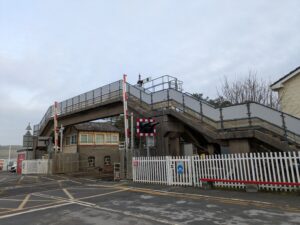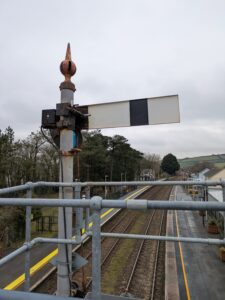
Ferryside signal box, February 2025
The clank of the semaphore signal is a rare aural hangover from the Victorian age. Yet it’s still an essential, if anachronistic, part of our mainline railway system, for a few short years or even months longer at least.
Express trains from Paddington on the main line between Llanelli and Carmarthen. west of Swansea, are still governed by this venerable technology.
Invented in the 19th Century, it is much older than not just the motor car, but electricity itself, developed and introduced by people who were alive when the first trains ran in the 1830s. Semaphore signals were dominant across Europe and the USA.
The signal box at Ferryside in Carmarthenshire itself dates from the 1880s. It is believed to be the best surviving box in the United Kingdom of its type, a GWR Type 3. It was given Grade II listing status in 2014. Some of the surviving signals, or parts of them, at Ferryside and other places on this section of line may not be very much younger.
Network Rail explains the need for the upgrade 68 miles of old signalling equipment, still controlled by signalmen pulling leavers at Ferryside and Pembrey and Burry Port, and replace them with ‘a brand-new state-of-the-art system’ of electric colour light signals is to ‘improve the resilience and reliability of passenger and freight journeys in the future’.
No justification is needed, really. The phase-out was inevitable. Elsewhere in the UK semaphore signals were largely removed by the end of the 20th century. But the fact that the system has been so successful, and still controls the movement of express trains in a few places on our railways in 2025 is a tribute to its efficiency.
This traditional type of signal was patented by Joseph James Stevens in the 1840s. By the 1870s, most British railway companies used semaphore signals. Some of the surviving signals at Ferryside and other places on this section of line, or parts of them, may not be very much younger.

Semaphore signal, Ferryside, February 2025
Trains are controlled by the signals, coloured mechanical arms that rise and fall to indicate ‘line clear’, ‘caution’ and ‘stop’, operated by levers worked by the signalman. The arms were originally fitted with oil lights behind different coloured lenses, to allow the signal to be seen at night, later replaced with electric lights. Semaphore signals will ‘fail-safe’ (default to danger, the ‘stop’ position), if the operating pull-wire breaks.
Ferryside Signal Box and the level crossing in front of it will live on as a painting by Edward Morland Lewis, Ferryside Railway Station, 1930s at the Newport Museum and Art Gallery (See link below). Lewis, who grew up in the village and went on to work under the influential Post-Impressionist C20th artist Walter Sickert, must have used the station every day to travel to school. Remarkably the scene is little changed today, 90 years on. A local conservation group plans to preserve the signal box when it is decommissioned later this year.
